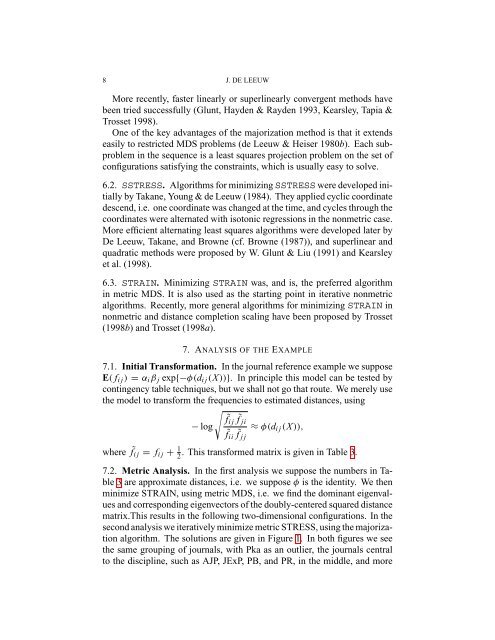Multidimensional Scaling - Convex Optimization
Multidimensional Scaling - Convex Optimization
Multidimensional Scaling - Convex Optimization
Create successful ePaper yourself
Turn your PDF publications into a flip-book with our unique Google optimized e-Paper software.
8 J. DE LEEUW<br />
More recently, faster linearly or superlinearly convergent methods have<br />
been tried successfully (Glunt, Hayden & Rayden 1993, Kearsley, Tapia &<br />
Trosset 1998).<br />
One of the key advantages of the majorization method is that it extends<br />
easily to restricted MDS problems (de Leeuw & Heiser 1980b). Each subproblem<br />
in the sequence is a least squares projection problem on the set of<br />
configurations satisfying the constraints, which is usually easy to solve.<br />
6.2. SSTRESS. Algorithms for minimizing SSTRESS were developed initially<br />
by Takane, Young & de Leeuw (1984). They applied cyclic coordinate<br />
descend, i.e. one coordinate was changed at the time, and cycles through the<br />
coordinates were alternated with isotonic regressions in the nonmetric case.<br />
More efficient alternating least squares algorithms were developed later by<br />
De Leeuw, Takane, and Browne (cf. Browne (1987)), and superlinear and<br />
quadratic methods were proposed by W. Glunt & Liu (1991) and Kearsley<br />
et al. (1998).<br />
6.3. STRAIN. Minimizing STRAIN was, and is, the preferred algorithm<br />
in metric MDS. It is also used as the starting point in iterative nonmetric<br />
algorithms. Recently, more general algorithms for minimizing STRAIN in<br />
nonmetric and distance completion scaling have been proposed by Trosset<br />
(1998b) and Trosset (1998a).<br />
7. ANALYSIS OF THE EXAMPLE<br />
7.1. Initial Transformation. In the journal reference example we suppose<br />
E( f i j ) = α i β j exp{−φ(d i j (X))}. In principle this model can be tested by<br />
contingency table techniques, but we shall not go that route. We merely use<br />
the model to transform the frequencies to estimated distances, using<br />
√<br />
f ˜i<br />
j<br />
˜<br />
− log<br />
f ji<br />
≈ φ(d<br />
f˜<br />
ii f˜<br />
i j (X)),<br />
j j<br />
where f˜<br />
i j = f i j + 1 2<br />
. This transformed matrix is given in Table 3.<br />
7.2. Metric Analysis. In the first analysis we suppose the numbers in Table<br />
3 are approximate distances, i.e. we suppose φ is the identity. We then<br />
minimize STRAIN, using metric MDS, i.e. we find the dominant eigenvalues<br />
and corresponding eigenvectors of the doubly-centered squared distance<br />
matrix.This results in the following two-dimensional configurations. In the<br />
second analysis we iteratively minimize metric STRESS, using the majorization<br />
algorithm. The solutions are given in Figure 1. In both figures we see<br />
the same grouping of journals, with Pka as an outlier, the journals central<br />
to the discipline, such as AJP, JExP, PB, and PR, in the middle, and more
















